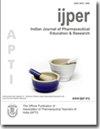Citrollenol Abrogates Neuroinflammatory Pathway Regulated via Induction of NF-kB in AlCl3 Induced Alzheimer’s Disease – Molecular Approach
IF 0.8
4区 医学
Q3 EDUCATION, SCIENTIFIC DISCIPLINES
Indian Journal of Pharmaceutical Education and Research
Pub Date : 2023-10-04
DOI:10.5530/ijper.57.4.127
引用次数: 0
Abstract
Abstract: Background: Alzheimer's Disease (AD), a neurodegenerative disorder characterized by dementia, is linked to ROS-induced stress, neuroinflammation, and gut microbiota imbalance. Objectives: The antioxidant and anti-inflammatory properties of citrollenol have already been reported. The current research was aimed at discovering the salutary properties of citrollenol against Aluminum Chloride (AlCl3 )-induced AD in rats. Materials and Methods: The AlCl3 was used to induce the AD in rats and then treated with citrollenol (25 and 50 mg/kg/bw). The behavioral tests were conducted on both control and treated rats. The levels of antioxidants and acetylcholine esterase were assessed using kits. The histopathological and immunohistochemical analyses were performed on the brain tissues. Results: The findings revealed that the AlCl3 -induced group had a loss of memory capability as well as an increase in the production of proinflammatory and neurodegenerative disorder-related AD proteins; otherwise, these characteristics were contrasted in the citrollenol-treated groups. Citrollenol-induced rats showed higher production of antioxidant enzyme levels and lower MDA status. Additionally, citrollenol abrogates proinflammatory mediator expression by suppressing NF-κB signaling and regulating microglial activation. Conclusion: Citrollenol can drawnback the AD brain tissue appearance of pathology study by leaking dysfunction in memory, learning capability, production of higher antioxidant enzymes levels, changing immunomodulatory cytokines levels in AlCl3 induced rats, exhibiting that AD pathogenesis may be represented by treatment with citrollenol via the neurodegenerative disorder causes from AD. Keywords: Alzheimer’s, AlCl3 , NF-kB, Malonaldehyde, Citrollenol, NeuroinflammationCitrollenol在AlCl3诱导的阿尔茨海默病中通过诱导NF-kB调节的神经炎症通路-分子方法
摘要:背景:阿尔茨海默病(AD)是一种以痴呆为特征的神经退行性疾病,与ros诱导的应激、神经炎症和肠道微生物群失衡有关。目的:已有文献报道了香茅醇的抗氧化和抗炎作用。本研究旨在探讨香茅醇对氯化铝(AlCl3)诱导的大鼠AD的有益作用。材料与方法:先用AlCl3诱导大鼠AD,再用25、50 mg/kg/bw的柠檬醇处理。行为测试分别在对照组和实验组大鼠身上进行。使用试剂盒评估抗氧化剂和乙酰胆碱酯酶水平。对脑组织进行组织病理学和免疫组化分析。结果:研究结果显示,AlCl3诱导组具有记忆能力丧失以及促炎和神经退行性疾病相关AD蛋白的产生增加;除此之外,这些特征在香茅醇处理组对比。citrollen醇诱导大鼠抗氧化酶水平升高,MDA水平降低。此外,citrollenol通过抑制NF-κB信号传导和调节小胶质细胞激活来消除促炎介质的表达。结论:Citrollenol可以通过AlCl3诱导大鼠的记忆功能、学习能力、抗氧化酶水平升高、免疫调节细胞因子水平的改变等途径,在病理研究中延缓AD脑组织的出现,提示Citrollenol可能通过AD引起的神经退行性疾病来表现AD的发病机制。关键词:阿尔茨海默病,AlCl3, NF-kB,丙二醛,Citrollenol,神经炎症
本文章由计算机程序翻译,如有差异,请以英文原文为准。
求助全文
约1分钟内获得全文
求助全文
来源期刊
CiteScore
1.40
自引率
0.00%
发文量
227
审稿时长
>12 weeks
期刊介绍:
The official journal of Association of Pharmaceutical Teachers of India (APTI) and is being published since 1967. IJPER, a quarterly publication devoted to publish reviews and research articles in pharmacy and the related disciplines of Pharmaceutical education. It mainly covers the articles of special interest, covering the areas of Pharmaceutical research, teaching and learning, laboratory innovations, education technology, curriculum design, examination reforms, training and other related issues. It encourages debates and discussions on the issues of vital importance to Pharmaceutical education and research. The goal of the journal is to provide the quality publications and publish most important research and review articles in the field of drug development and pharmaceutical education. It is circulated and referred by more than 6000 teachers, 40,000 students and over 1000 professionals working in Pharmaceutical industries, Regulatory departments, hospitals etc.

 求助内容:
求助内容: 应助结果提醒方式:
应助结果提醒方式:


